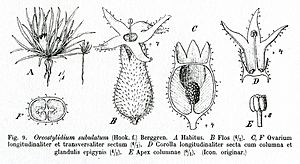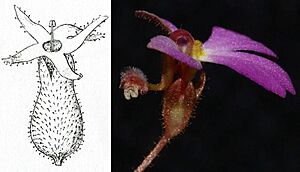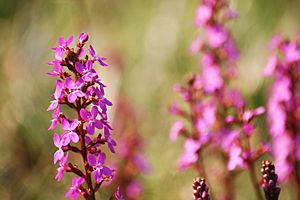Oreostylidium facts for kids
Quick facts for kids Oreostylidium |
|
|---|---|
 |
|
| Diagram from Mildbraed's monograph of Stylidiaceae in 1908 | |
| Scientific classification | |
| Genus: |
Oreostylidium
|
| Species: |
subulatum
|
| Synonyms | |
|
Stylidium subulatum Hook. 1864 |
|
Oreostylidium is a special group of flowering plants. It belongs to the family Stylidiaceae. This group has only one known species, called Oreostylidium subulatum. This plant is found only in New Zealand. This means it is endemic to that country.
O. subulatum is a very tiny plant. It grows small, white flowers. Scientists have studied its history. Some think it should be moved into a related group called Stylidium. This is because of its DNA and how its flowers developed. It even has special sticky hairs like some Stylidium plants. These hairs can help Stylidium plants catch insects. But scientists are not sure if Oreostylidium also eats insects.
Contents
What Makes This Plant Special?
Oreostylidium subulatum is a very small plant. It grows in dense clumps. It is usually only about 2 to 3 centimeters tall. Its leaves are about 2 centimeters long. They are thin and grow in a circle close to the ground. This circle of leaves is called a rosette. The leaves are smooth and have no hairs.
A thin stem, called a scape, grows up from the leaves. This stem is also about 2 centimeters tall. Like many plants in the Stylidium group, this stem has sticky, glandular hairs. Each stem grows just one flower. The flower has a strong base called a calyx. This base is wide and supports the flower's ovary. The ovary is the part that holds the seeds.

The flower of O. subulatum is white and has five petals. It looks like a star. Its flowers are similar to those of Forstera and Phyllachne plants. These are also in the Stylidiaceae family. Like all Stylidium species, O. subulatum has a special part called a column. This column is made of fused male and female parts of the flower.
However, the column in O. subulatum is different. It does not move when touched. Most Stylidium plants have a column that snaps quickly. This helps them spread pollen. Scientists think Oreostylidium might have changed over time. It may have developed a simpler flower. This change might have happened because it was isolated in New Zealand. It might have come from Australia as a single seed. To survive in a new place, it adapted. Its flowers became simpler. This allowed it to pollinate itself. It did not need specific Australian insects anymore.
Where This Plant Grows
Oreostylidium subulatum is found only in New Zealand. It grows in mountain and subalpine areas. These are high-altitude regions. Its range is not as wide as other similar plants in New Zealand.
In 1925, a scientist named Good said it was only on the South Island. But earlier reports mentioned some plants near Mount Ruapehu on the North Island. On the South Island, it has been found near Dunedin at Swampy Hill. It also grows at The Grampians near Nelson, New Zealand.
How Scientists Classified This Plant
The plant Oreostylidium subulatum has a long history of being classified. Sir William Jackson Hooker first described it in 1864. He called it Stylidium subulatum. He put it in the Stylidium group. He looked at its fruits and where it grew.
In 1878, Ferdinand von Mueller thought it should be in the Phyllachne group. He looked at its flowers. But in the same year, Sven Berggren created a new group for it. He called this new group Oreostylidium. This is the name most scientists use today.
William Colenso described a new species in 1887. He called it Oreostylidium affine. He thought it was different from O. subulatum. But he was not completely sure. He noted that the places where they grew were very similar. Also, some of his plant samples were damaged. Later, O. affine was considered the same as O. subulatum.

For many years, Oreostylidium stayed in its own group. Then, in 1998, scientists did a big study. They looked at the plant's features and its DNA. They found that Oreostylidium seemed to fit inside the Stylidium group. Because of this, they suggested that O. subulatum should go back to its first name, Stylidium subulatum. They also suggested that Oreostylidium should no longer be its own group.
In 2002, another study used more DNA evidence. They found that Stylidium graminifolium and O. subulatum were very closely related. They shared a common ancestor about 3 million years ago. This study also concluded that Oreostylidium should be moved into the Stylidium group. So, O. subulatum would again be called Stylidium subulatum.
Images for kids
-
Comparison of the floral structure of Oreostylidium subulatum (left, diagram) and Stylidium turbinatum (right). O. subulatum has an insensitive, erect column whereas members of the genus Stylidium, like this S. turbinatum, possesses a sensitive, elongated column that aids the plant in cross-pollination.
-
Stylidium graminifolium flower spike. Molecular evidence suggests that S. graminifolium is the most closely related Stylidium species to O. subulatum.
See also
 In Spanish: Oreostylidium subulatum para niños
In Spanish: Oreostylidium subulatum para niños




